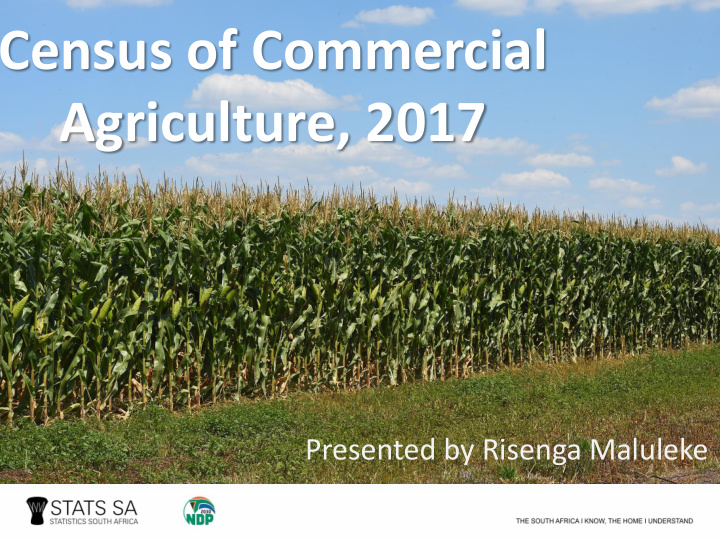



Census of Commercial Agriculture, 2017 Presented by Risenga Maluleke
THE MANDATE OF STATS SA Stats SA adheres to Stats SA (through the SG) Stats SA (through the SG) According to section 17 of international best is responsible for official is independent since the Statistics Act, any practice in terms of statistics in the country. according to section 7 of information collected on standards and methods, Official statistics are the Statistics Act, 1999 a household, farm or specifically the United designated as such by the Nations Principles of (Act No. 6 of 1999) it has business remains Statistician-General. Official Statistics. the ‘final responsibility’ confidential to Stats SA. on the collection, The results are presented processing and in an aggregate form only. dissemination of data.
INTRODUCTION Stats SA signed an MoU with the Department of Agriculture, Forestry & Fisheries (DAFF) early in 2018, according to which 1 Stats SA is to conduct a Census of Commercial Agriculture for 2017 (CoCA 2017), and 2 DAFF is to develop a Farmers’ Register, with special focus on small-holder farmers.
OBJECTIVES THE CENSUS OF COMMERCIAL AGRICULTURE The general objective of the 2017 Census of Commercial Agriculture is to collect basic quantitative information on South Africa’s commercial agriculture that is essential for planning, policy formulation, food security, etc. 1 To generate information on the size, structure & nature at municipal level on the structure of commercial agriculture, SPECIFICALLY 2 To provide data to use as benchmarks for and reconciliation of current agricultural statistics 3 To improve frames (lists of farms) to be used for conducting commercial agriculture sample surveys.
BACKGROUND The conducting of a Census of Agriculture started in 1918. The results 01 were published in July 1919. Until 1980, the census of agriculture was conducted every years, 02 except from 1940 to 1945 (World War II) The frequency decreased over the years to a five-year interval. 03 The last Census of Commercial Agriculture before 1994 was conducted for 04 1993, and excluded the former TBVC states.
BACKGROUND Since ‘Freedom Day’ in 1994, Statistics South Africa has conducted 05 Censuses of Commercial Agriculture (Farming) for 2002 and 2007. The 2012 Census of Commercial Agriculture was not funded and as 06 such didn’t take place This is part of FAO’s WCA 2020 (World Programme for the Census of 07 Agriculture) which encourages countries to conduct agricultural censuses between January 1st, 2016 and December 31st, 2025.
IMPORTANCE OF THE CENSUS OF AGRICULTURE (FAO) AGRICULTURAL PLANNING: contributing to the development of policies on food security or gender issues, and promoting agricultural production and investments, economic growth, rural development, etc. RESEARCH, INVESTMENT & BUSINESS DECISIONS: providing crucial data for the research and appraisal of the composition, distribution and past and prospective growth of the sector. AGRICULTURE AND THE ENVIRONMENT helps decision-makers and planner when adopting measures to mitigate adverse effects; FOOD SECURITY providing data for assessing severity of food insecurity
IMPORTANCE OF THE CENSUS OF AGRICULTURE (FAO) WORK IN AGRICULTURE supporting labour and other social policies related to the quality of employment through the provision of data on status in employment of main job and on forms of payment on an annual basis; THE ROLE OF GENDER providing gender disaggregated data to help monitor progress towards achieving gender equality goals. BASELINE DATA FOR M&E helps giving detailed structural data for small geographic areas CONTRIBUTION OF AGRICULTURE IN NATIONAL ACCOUNTS information to define structural components of the national accounts, data as inputs of the System of Environmental- Economic Accounting (SEEA), or for benchmarking (establishment of base year ) national accounts.
SCOPE AND COVERAGE (COCA 2017) The census of commercial agriculture will cover commercial farming (for profit) in crop production, livestock farming, fisheries and forestry as classified by the 1993 Standard Industrial Classification of all Economic Activities (SIC). Fisheries Crop Game farming Livestock (including marine production and Forestry farming aquaculture)
SCOPE AND COVERAGE (COCA 2017) Stats SA’a business register (BR) will the be main frame (list) . The business register is based mainly on the value-added tax (VAT) register of the South African Revenue Service (SARS). Area/ geographic frame will be used to improve coverage.
DATA ITEMS General information, Land use by composition and area of the farm/forest Field and horticultural crops: Area planted and production by this farm Animals (livestock, game, poultry, bee-hives) sold Forest produce Ocean (marine) fishing Sale of livestock, poultry and game products and processed produce Employment Income and expenditure Details of purchases Carrying value of assets Details of the principal farm manager/ operator
Data Collection And Dissemination Publicity will be conducted through Fieldworkers will visit local farmers’ farms to conduct associations, interviews using security firms and tablets. police stations and also at farm level. As safety is important, farmers can direct A fieldworker will be their queries identified by wearing bibs with Stats SA logo, • Tel: 0800 212 169 (toll-free number) ID cards and cars • e-mail is: branded with Stats SA agriculture@statssa.gov.za logo.
Data Collection And Dissemination Overall, Stats SA will be observe the Farmers’ Protocol as agreed with organised agriculture. “ We count because Farmers Count” “ Ons tel omdat die Boere tel ”
Data Collection And Dissemination Results will then be published Begin field data collection End field data collection Sep Oct Nov Dec Jan Feb Mar Apr May Jun Jul Aug Sep Oct Nov Dec 2019 Follow-up collection begin
“ We count because Farmers Count” “ Ons tel omdat die Boere tel ”
Recommend
More recommend